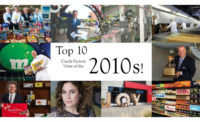
Timothy Childs, Tcho's chief chocolate officer, basks in a collection of cocoa pods. by sourcing from specific growers for distinct flavor characteristics, the company looks to produce six distinct chocolates, such as the "Fruity" beta version shown.
“Be regular and orderly in your life, so that you may be violent and original in your work.”
- Gustave Flaubert
French novelist (1821 -1880)
"The reasonable man adapts himself to the world; the unreasonable one persists in trying to adapt the world to himself. Therefore, all progress depends on the unreasonable man."
--George Bernard Shaw
Irish dramatist & socialist (1856 - 1950)
“Scrappy but not crappy.”
- Timothy Childs
Chief chocolate officer (1963- )
One would be hard-pressed to call Timothy Childs violent. And those who deal with him in business would hardly call him unreasonable. As for original, even Childs says he’s using ideas, concepts and practices from industries that’s he’s been involved with in the past.
Yet, those quotations cited in the beginning of this article haven’t been chosen at random. They’re what visitors see when they walk into Tcho’s front office inside Pier 17 on Embarcadero Drive in San Francisco.
A glance at one corner of a wide open room filled with tables, computers, packaging and chocolate samples reveals a large white board featuring those first two quotations.
Nevertheless, the thrust behind Timothy Childs’ “scrappy but not crappy” chocolate company, one that features such investors and company participants as Louis Rosseto, founder of WIRED magazine and company ceo, Karl Bittong, 40-year chocolate industry veteran, and John Kehoe, former specialty bean broker extraordinaire and director of sourcing and farmer relations, does border on, let’s say, unconventional.
One might call it an obsession, one that melds quite nicely with Childs’ expertise and training in 3-D computer imaging and entrepreneurial drive.
It was exactly that combination that propelled him to become a specialized supplier for NASA’s Space Shuttle.
And it was that sense of curiosity that, upon hearing of the Columbia tragedy on February 1, 2003, led him to channel his energies and instincts into chocolate.
Figuring that the Space Shuttle program would be put on hold for an indefinite period of time, he sought out new ventures. Upon being recruited by a past colleague to capitalize on the next food trend-single-origin dark chocolate, Childs plunged himself into discovering the world of cocoa bean sourcing and processing and chocolate manufacturing.
As it turned out, NASA’s determination to restart the Space Shuttle program translated into a mere seven-month hiatus. During that time, however, Childs had been seduced by theobroma and was grease deep into a joint venture, Cabaret Chocolates.
The low-budget, seat-of-the-pants startup proved educational, prompting him to get close and personal with worn chocolate processing machines in an aging Oakland facility.
When it became apparent that Cabaret’s vision didn’t mesh with his, Childs opted to go solo, enlisting help from professionals in and outside of the industry.
A trip to interpack 2005, a telephone call from Germany about an opportunity to purchase a used but still workable chocolate moulding line and a chat with friend and partial financier Rossetto, helped “crystallize” Childs’ vision of Tcho (pronounced “cho”), a company where “technology meets chocolate” a hybrid whereby “Silicon Valley meets San Francisco food culture.”
“In looking at the chocolate industry, we examined the areas where we could make the most effective change, where we could have the most impact with the least amount of effort,” Childs explains. “How could we disrupt it? In the end, it’s not the most innovative industry. I wanted to introduce a startup Silicon Valley mentality to a traditional system.”
To do so, Childs and his team focused on the two most critical elements of chocolate: terroir and taste. By addressing those two endpoints, Tcho could become the conduit for a more satisfying supply loop for both the farmer and the consumer. In Childs’ mind, closing the loop between these two points would introduce a new model for chocolate makers in the industry.
One of the first groundbreaking applications Childs introduced to the company involved consumer understanding of the chocolate experience. Instead of cocoa content percentages, the chief chocolate officer (Childs’ official title) developed a flavor wheel, one that neatly divides chocolate into six primary taste experiences: nutty, fruity, chocolatey, citrus, earthy and floral.
“We wanted to simplify the experience for the consumer, simplify the buying process,” he explains. “If it was hard for me to understand, it’s hard for consumers. People begin to link percentages to quality, levels of cocoa, concentration of sweetness. It’s actually not the best information.”
“So we came up with a model that simplifies the chocolate universe,” Childs continues. “We looked at all the different flavor wheels out there, examined models that worked in other fine foods and applied it to chocolate. In effect, we developed a new taxonomy.”
The flavor wheel, of course, has applications to the other end of the loop, the farmer.
“We want to work with farmers so that they develop fine beans that have those inherent characteristics,” he goes on. “By using some science and technology, we can pull out those flavors, strip out other flavors that pull away from it.”
Imparting that science and technology to the farmer, to the growing areas represents a key element of Tcho’s raison d’etre. Initially, the effort will focus on fermentation and drying of the cocoa beans.
As Childs emphasizes, basic improvements such as an $1,800 cascading fermentation box can go a long way into improving the fermentation level, raising it from 60% to 75% or 80%. Ensuring that beans are dried on elevated bamboo racks (and not concrete) to ensure proper venting of volatiles, costs less than $200.
To that end, Tcho has established a new sourcing platform dubbed Tchosource, says John Kehoe. Having been involved with cocoa beans since 1990, Kehoe knows and understands the issues farmers and buyers face. He also knows that Tcho’s vision, which focuses on the quality of the cocoa at its source, isn’t just lipservice or, in today’s world, merely Web speak.
“We’re devoting significant funding for investments in origin with our partners. The main focus will be quality improvement, quality understanding, flavor dynamics and technology to help create as well as highlight certain flavors,” he says. “Our aim is to go beyond Fair Trade, dealing directly with farmers. Many companies just buy the label and pay the premium.”
Tcho’s investment will take traceability to a new level, involving not only test cuts with farmers, but replicating roasting, winnowing and conching in the field through on-site “Flavor Labs” and then collecting that data to document the process for specific samples.
“Tchosource will bring technology and innovation to origin,” Kehoe adds. “Infrastructure is key. We believe in appropriate technology. In addition to field labs, we will be monitoring fermentation through sensors to determine what exactly is happening in the fermentation process. Genetics [origin] represent the potential. That potential is realized in the fermentation, drying and processing.”
What’s remarkable about Tcho is how quickly the company has begun to implement its vision, both in the field and at Pier 17. A quick tour of the 25,000-sq.-ft. historical location (second oldest pier in San Francisco) first takes visitors to Childs’ mini lab, a compact wormhole that essentially replicated a $20,000 operation in warp speed for less than $3,500.
Amidst a turkey roaster adapted for cocoa beans, a jerry rigged beer hops grinder, a modified Shop Vac winnower, and a series of wet food grinders featuring several clothes drier ducts affixed with Space Shuttle tape, Childs has added temperature control units, infrared thermometers and a DCD (digital camera direct) camera to record everything that goes on in the lab.

Timothy Childs' improvised laboratory. (Photos by Douglas Adesko/featured in Make Magazine.)
The technology, as one would expect, extends onto the plant floor, where a 1972 chocolate moulding line, complete with a new MacIntyre refiner, conches and ball mills as well as a Nagema moulding line that once featured wooden cooling tunnels, have been taken apart, rewired and revamped as only a Space Shuttle technologist could imagine.
Having worked with Siemens reseller, Serra, in the past, Childs was able to cajole his friends at the company to partner with Tcho in putting in totally new control systems at a reasonable cost as part of a partnership program involving training new hires.
As Childs points out, “We’ve even put in windows in the control panels. It’s all part of the Geek culture - making the unseen seen.”
Through the use of computer graphics, simulation and video cameras linked to WonderWare software that also enables virtualization throughout the company’s computer network, as well as help from researchers at FX/PAL (Fuji Xeror research center in at Palo Alto, Calif. - another partnership), Childs will be able to view and control production on the line and in his lab by simply connecting to the system via his iPhone.
DuringCandy Industry’svisit, the company was in the last stages of testing the equipment, gearing up to do test runs on the line in November. In the interim, the company has been producing its “beta” bars within a self-contained 44-ft. shipping container.
Complete with a tempering unit, a depositor and cooling racks, the temperature- and humidity-controlled container can put out a ton of chocolate in one eight-hour shift.
It has been the workhorse for Tcho in getting its beta products out to locals in San Francisco as well as supplying consumers through its Web site sales.
The beta concept, which of course has its origins in Silicon Valley, dovetails the idea of continuous improvement into chocolate production. Simultaneously, the beta concept encourages consumers to provide feedback via the Web as Tcho develops its line of chocolate bars.
Having debuted first with “Chocolatey” beta bars, the company has rolled out “Nutty” and “Fruity” versions, and will launch “Citrus” due out in the next few weeks.
In ultimate scrappy but not crappy style, Tcho opted to use Army surplus, poly-lined kraft envelopes used for spare parts to package its 50-g. beta bars. Minimalistic labeling provides country of origin, cacao percentage and the beta batch number, which contains the flavor profile (for example, f stands for fruity), and the version number of the release, 0.XX.
“We were aiming at creating pull while simultaneously allowing us time to ramp up,” Childs explains. ”We’ve been selling online for about nine months and have found our customers are really into our Beta process. More than 46% of our customers come back to our Web site and give us feedback on the chocolate.”
Most importantly, the feedback has been overwhelmingly favorable.
Those responses have fueled Childs and his management team to work furiously to complete the transformation of Pier 17 into a “transparent” chocolate retail and manufacturing complex.
The design, created by Los Angeles-based Uebersee, will feature a retail shop, tasting room, video room, demo kitchen, laboratory, cooling space, chocolate production area and bean roasting, cracking and winnowing area.
“Visitors coming into the shop will be able to see all the way into the factory,” Childs says. “It will be a blending of art and science.”
Part of that art and science will include linking the farmer to the consumer. As Childs says, the advent of web cams and portable satellite transceivers, will enable the company to visually connect with farmers in the region discussing a cacao pod’s particular characteristics.
“It’s all about building a connective layer between the farmer and the consumer,” he says.
Tcho’s understated Beta packaging will soon be replaced with a more compelling signature design, one that uses algorithmic patterns color coded to Tcho’s flavor wheel. The chocolates themselves will also feature those same patterns moulded onto the surface.
For Childs, the patterns represent the integrated levels of complexity inherent in chocolate. As one scratches the surface and bores down, there are many more discoveries.
In boring into Tcho’s business plan, it’s clear that consumer sales represent only one cornerstone of the company’s strategy.
“We want to supplement our consumer sales with business-to-business activity, comprising of contract manufacturing as well as private label,” the chief chocolate officer emphasizes. Childs, however, promises an aggressive, scrappy effort on both fronts.
Count on it.

Louis Rossetto, chief executive officer of Tcho. (Photo courtesy of Jio Ito.)
'Wired' into chocolate
Becoming actively engaged as a chief executive officer of a fledging entrepreneurial startup was the furthest thing in Louis Rossetto's mind as he strolled into the University of California's chancellor's residence in Berkeley four years ago.There to hear David Byrne lecture on PowerPoint presentations as art, the journalist-turned-founder/publisher ofWired magazine had quietly retreated from covering the digital culture afterWired'ssale in 1998. Focused on supporting selective projects through a holding company that he and his partner, Jane Metcalf, had created after their exit fromWired, Rossetto had no intention of doing "another Web thing."
"Here I was in the midst of a bunch of academics when someone offered me a box of chocolates from a company called Cabaret Chocolates," he recalls. "It was the best chocolate I had ever tasted in my life."
Not only was it spectacular, but it turned out that Rossetto actually knew the fellow who made it, Timothy Childs.
"Back in the day, Timothy had been a housemate of Amy Crichett, the sixth employee I hired in the early days ofWired. I'd often bump into him over the years, our paths crossing since he was a technologist."
"So I wound up buying a few boxes of the ganache Childs made," Rossetto continues. "He would produce it at Hooper's Chocolate in Oakland, working when the facility shut down on the weekend. Childs would make a batch, mould it and have it ready by the time the first shift arrived, at about six or seven in the morning. He'd then sell it store-to-store, door-to-door, until he had to make another batch."
Although Rossetto joked about becoming involved in chocolate, he wasn't really serious - until that day in December 2005- the day Childs called him about an "opportunity of a lifetime."
"Childs' partner, Karl Bittong, had discovered an entire chocolate processing and moulding line at a factory located near Dresden, Germany. He asked me to help finance it."
That set in motion a series of events, ones that saw him eventually join the company as its chief executive officer in May 2007.
"It was obvious then that Childs needed a partner with serious startup experience to handle details involving finance, marketing, personnel so he could channel his energies into sourcing and chocolate making."
Having gone through the birth of a critically acclaimed and groundbreaking publication likeWired, and especially its tumultuous web operations, Rossetto understood the pitfalls of being a visionary.
"Timothy reminded me of myself in the early days ofWired," he says. "He was obsessed with wanting to create something amazing."
Thanks to Rossetto's help, Tcho has garnered enough investors, a group of 60 family and friends, to establish a financial base. With a bit of media serendipity (Rossetto's friends on theNew York Timesset in motion a deluge of media coverage(, the company has created an almost cult-like following on the Internet through its Web site. And thanks to additional financing, it's gradually put an infrastructure (people and processes) in place to jumpstart a "pod to palette" business. As a result, the company looks to kick off testing of mass production next month, launch new packaging in time for the coming holidays and open a retail store/cafe as part of its factory complex early next year.
What's particularly exhilarating for Rossetto is the fact that this startup - akin toWired - is dead earnest about creating a great brand and a great company.
"It stems from the passion of the people involved," he explains. "And we're doing this without a net; there is no financial support from the likes of a Mars or a Conde Nast. At our core, we just have this insane belief in producing great chocolate."
At a glance
TchoHeadquarters: San Francisco
Size: 25,000 sq. ft.
Product: Single-origin chocolates
Management team: Timothy Childs, chief chocolate officer; Louis Rossetto, chief executive officer; Tom Twietmeyer, chief operating officer; and John Kehoe, director of sourcing and farmer relations.






